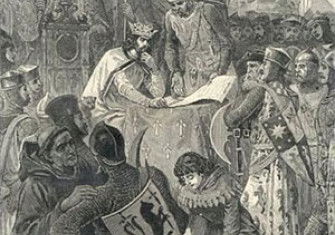The Meaning of Magna Carta since 1215
Ralph V. Turner considers how and why Magna Carta became a beacon of liberty in Britain and, increasingly, in the United States.
 Most students of English history know that King John’s barons forced him to grant Magna Carta, the great charter of liberties that placed the English king under the law. They know that this charter, agreed by John in 1215 at Runnymede meadow and confirmed in definitive form by Henry III in 1225, is a crucial document for England’s history, likely the best known of all documents surviving from medieval England. Its attempt to impose the law’s limitations on a ruler is summarised in Chapter 39:
Most students of English history know that King John’s barons forced him to grant Magna Carta, the great charter of liberties that placed the English king under the law. They know that this charter, agreed by John in 1215 at Runnymede meadow and confirmed in definitive form by Henry III in 1225, is a crucial document for England’s history, likely the best known of all documents surviving from medieval England. Its attempt to impose the law’s limitations on a ruler is summarised in Chapter 39:
No free man shall be taken or imprisoned, or dispossessed or outlawed or exiled or in any way ruined, nor will we go or send against him except by the lawful judgement of his peers or by the law of the land.






